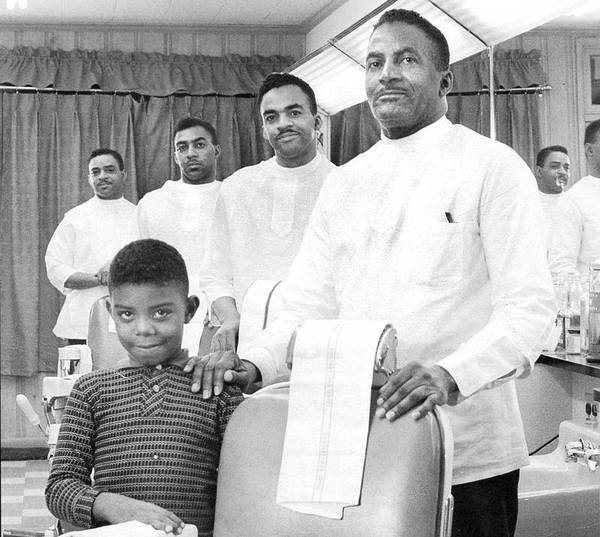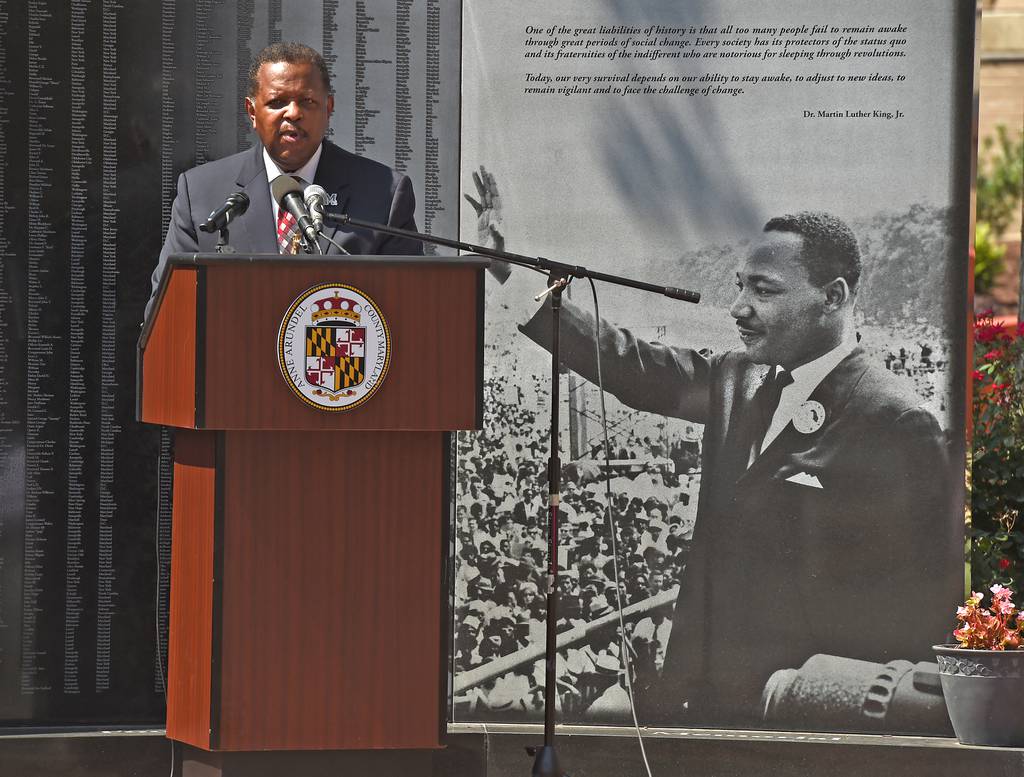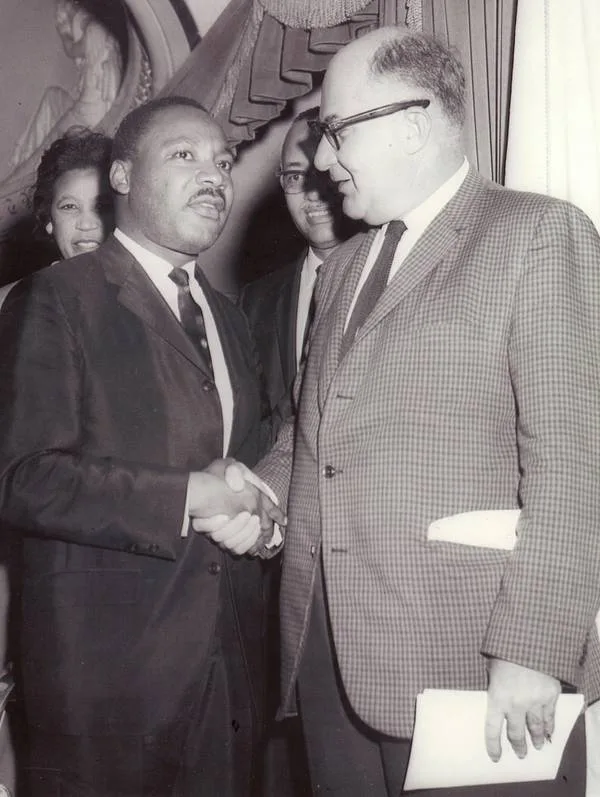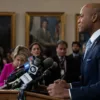From an early age, George Trotter had no choice but to be political. A student inside Annapolis’ segregated classrooms with no father figure at home, he craved guidance — finding it along West Street on the floors of the Chambers Barber Shop.
Sweeping hair and running errands, Trotter remembered the Chambers as being active in every facet of their community. They were political, religious and social leaders. Shop owner and preacher John T. Chambers Sr., was a founding member of the local NAACP chapter, while John T. Chambers Jr. would be appointed from alderman to the city’s first and only African American mayor in 1981. Along with Carroll and Phillip Chambers, who worked the shop with their father and brother, the family became quick and lifelong mentors for Trotter.
Remembering his many years with them, Trotter likens himself to a sponge. The Chambers’ words and ideas helped shape his own; their passion inspired him, and their connections took him far beyond the bounds of the city’s old Fourth Ward. And on Aug. 28, 1963, that included the March on Washington.
“Ironically,” said Trotter, now 76, “having been associated with the Chambers family and all of its family members, I became a part of history.”

Sixty years ago, Trotter was one of nearly 250,000 people who traveled to Washington D.C. to peacefully push for the civil and economic rights of African Americans. The enormous display pressured national leaders into cementing several freedoms a year later, securing voting rights and forbidding academic, commercial and employment segregation.
Though the Chambers drove Trotter to the nation’s capital that day, many of the hundreds of Annapolis residents who attended The Great March traveled on buses, gathering near the barbershop on the corner of Calvert and Clay streets. Today, a memorial commemorating these “foot soldiers” decorates that side of People’s Park, an homage itself to the ward Trotter grew up in and the prominent Black neighborhood eventually demolished by urban renewal policies.
Many of those still alive to remember the March on Washington were children or teenagers at the time, brought together by those politically engaged around and, at least in part, for them.
Sixty years later, these younger foot soldiers remember the sights and sounds that still carry the day in classrooms, museums and memorials. But they also remember, with fondness and gratitude, the people in their lives who brought them there.
“As young people, we were getting a guidance, an education on who we are, what our mission is and what we should be doing,” said Larry Diggs, an activist and former freedom rider from New York who now lives in Bel Air. “And that became evidently clear because we were supported by adults who were there with the same mindset. We were learning as we were going along.”
In 1963, at the age of 20, Diggs was already a well-worn demonstrator, a quality he inherited from his mother Estella. After “hopscotching” around the country during the Great Migration, Estella Diggs helped families fleeing the Jim Crow South set roots in Morrisania, an African American enclave of the Bronx.
Diggs said his mother’s passion for others and her ability to achieve progress as a legislator — she was the first African American woman from the Bronx elected to the New York State Assembly — taught him a valuable lesson.
“The women were the fundamental foundation of organization and function in our community,” Diggs said, adding to this day, he celebrates the election or promotion of any woman into power.
“I understood from the beginning what it was about, who was really the foundation of our communities,” Diggs said. “That’s not just in the Bronx. That’s all over this country.”
The night before the March on Washington, Diggs joined his mother and two of his aunts on a caravan of three buses, each containing about 50 people.
Diggs still remembers the fear he saw in those around him. Many of his neighbors had not returned south since they left, and not expecting a warm welcome at any hotels or restaurants along the way, they morphed their convoy into an entire accommodation. The buses’ back aisles became cafeterias, stocked with home-cooked meals, and pots were the best choice for toilets.
As they approached Washington the next morning, Diggs quickly learned they were hardly the only people who had made the arduous journey.
“It was enormous,” Diggs said. “Nobody could have ever imagined that the reaction was going to be as it was.”
Estimates place the number of marchers somewhere between 200,000 and a quarter of a million people. Regardless, the reality far exceeded the expectation and though police were caught off guard by what could have been an “unmanageable” crowd, Diggs said everyone’s conduct, “the people,” was the most important part of the day.
“We recognized, as African Americans, we were putting our best foot forward,” Diggs said. “We [had] to put our best foot forward because this was our opportunity to shine and show who we really were…to show that we had value as a race of people.”
Facing the Lincoln Memorial, where the headliners were set to speak, Diggs and his mother planted themselves along the right side of the reflecting pool.




Trotter and the Chambers family had managed to find a spot closer to the front, squeezing in somewhere between the water and the memorial’s granite steps.
Through the Chambers, Trotter had traveled along the Eastern Shore and connected intimately with the political scenes of Annapolis and Baltimore. But this was an eye-opening moment.
“It was a tendency at that particular time to only see the local perspective of things,” Trotter said. “When I arrived at the March on Washington, I could see it nationally, as well as globally, what impact the movement had.”
Marc Apter, in a way, was a bit more familiar with the scope and scale of the day. His father, David, was a public relations man and had volunteered his services for the march. When the bosses at his cushy, full-time job pushed back, he quit.
Only 17 at the time, Apter wasn’t too involved in politics, but remembering what led up to the monumental day, he said it “wasn’t all sweetness and light.”
Like many civil rights demonstrations, there were concerns about counter-protests and terrorism — one fear Apter recalled was that the Ku Klux Klan was preparing to poison the capital’s water supply — and his mother didn’t want him to go. But David Apter pushed for his son’s help.
Apter said his father was in the awkward position of managing the wills and wishes of several passionate organizations, each with their own talking points and rules of conduct for the others. Once a speech or note was signed off and approved, Apter ran up the steps of the Lincoln Memorial to deliver it.




The speeches themselves didn’t interest the teenager, who was in awe of the stars around him: actors Sidney Poitier, Paul Newman and Marlon Brando, as well as performers like Harry Belafonte and Bob Dylan. With a taste of remorse, Apter mentioned not talking to Joan Baez, the folk singer whose rendition of “We Shall Overcome” closed the ceremony.
One speech did manage to catch his attention, however. It was the one that would come to define the day and eventually, the movement: Martin Luther King Jr.’s “I Have a Dream” speech.
“I just sort of realized there was something more meaningful that he was addressing and that the crowd was responding to,” Apter said. “It spoke to me.”
Diggs remembers King’s speech well and has studied it over the years. Even now, he encourages people to take the time to hear King’s words.
“It gave us all the pride of understanding who we were,” Diggs said, “and the dignity of being affiliated and associated with a historical event, such as it was.”
Sixty years later, Diggs said all the March on Washington came down to was, “who we were, where we were, what we were there for and what we did after that.”
For his part, Diggs remained committed to the fulfillment of civil rights in his personal and professional life, implementing affirmative action within the New York state government. After his retirement in 1998, he moved to Maryland in 2005 and began working with the Caucus of African American Leaders in 2013, alongside Trotter and its convenor Carl Snowden.
In the decades since 1963, Apter has adopted his father’s sense of advocacy, spearheading the publicity effort on a variety of civil rights projects, including celebrations 20 and 30 years after the historic march.
“I’m very grateful to my dad that he introduced me to the impact of civil rights on us all,” Apter said. “And I am proud that I, in some way, have followed suit and followed up on his initiatives.”
Daily Top Stories
Daily
Get the day’s top news, sports, opinion, features and local events.
In 2014, the Anne Arundel County Martin Luther King Jr. committee presented Apter with an award for his work on the Foot Soldier Memorial in Annapolis, which honors the hundreds of Anne Arundel Citizens who attended the March on Washington.
Arlene Jackson is one of those people.
Now living on the Annapolis Neck peninsula, Jackson grew up in Washington’s Park View neighborhood, not far from Howard University. She doesn’t remember much from the march — she was only 9 years old then and overwhelmed by the crowds — but when it came time for her name to be etched onto the memorial, she pushed to include that of an outsider: her brother, Reginald H. Booker.
“He was a giant,” Jackson said. “He was like a hero to me.”
From the mid-1950s through the 1970s, Booker led several social justice movements throughout Washington. He pushed against the Vietnam War and police brutality, while advocating for public transportation and workers’ rights. He attended his first sit-in when he was 13, Jackson said, protesting Jim Crow at a local lunch counter.
Jackson had seven siblings but was the only one Booker took to the march. Though she never asked him herself, Jackson said she can guess the reason why.
“I didn’t know the value or the importance of being in the midst of those kinds of environments or crowds,” Jackson said. “I was suddenly in a struggle I didn’t even realize was a struggle.”


